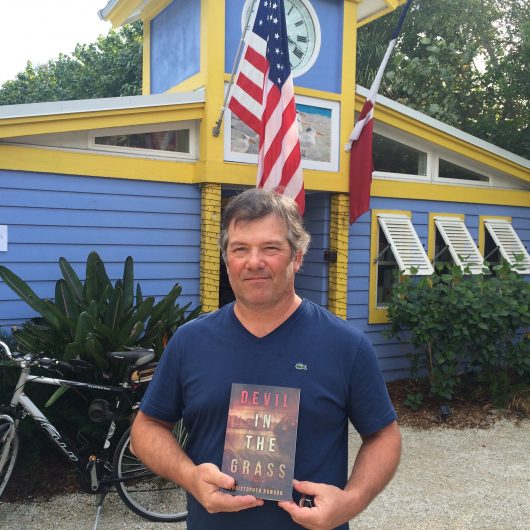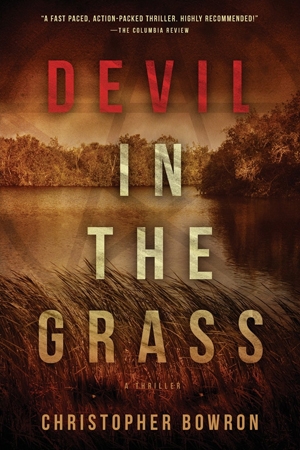
Debut author Christopher Bowron’s novel Devil in the Grass comes out 1 March. It’s a lively exploration of two great divides that characterise its South Florida setting: wealth versus poverty, and developers versus environmentalists. Add in the special concerns of the native Seminole population at long-term odds with a local family of killers and a below-the-radar group of Satanists. Top it off with forces of nature such as extreme weather and deadly critters. We asked Christopher how this exciting mixture of ingredients came together in his first book…
What aspects of Devil in the Grass do you think will most intrigue crime fiction readers?
At its core, Devil in the Grass is about a Satanic cult – the Church of Set – whose members resort to blackmail, murder and extortion to achieve financial gain. In addition, there is a family of ‘cleaners’, the McFaddens, who make a living tidying up the messes other lawbreakers have made. I think readers will enjoy not just the protagonist, Jackson Walker, but also the character Janie Callaghan, a paralegal who does investigations for a criminal lawyer. Essentially, Devil in the Grass is a crime thriller, and I think crime readers will be happy.
Your regular profession – heading a prominent Canadian real estate firm – isn’t the usual background for a crime writer. How has that contributed to the novel?
In 28 years, I’ve seen the best and the worst of people as real estate transactions go either in their favor or not. I’ve seen a lot of different personalities and become adept at reading people. I took Janie’s character from someone I knew who, tragically, drank herself to death. So, yes, I do try to put some of the idiosyncrasies I have seen in people into my fictional characters.

I especially liked how the sawgrass swamps of the Everglades and the dangerous critters who live there are almost characters in themselves.
I’m an avid shark fisherman and frequently catch big Bull Sharks that I have to wrestle out of the surf by the tail. From what I have experienced and have read about alligators, if you treat them with respect, you will never have a problem. For the most part, all they want is for you to go away. My poem at the beginning of the book expresses my point of view about the Everglades, too.
Your novel has considerable diversity in its female characters. How did you develop them?
I don’t think that a male would have fit any of the roles the female characters play. Janie is the saddest – warm and clever, but her underlying issue is failed potential, which is evident in a lot of people who end up living in Florida. When young, they have the world by the tail, but as they grow older, the sun and the fun take their toll.
Fictional antagonists, like always-in-control Henrietta (the Satanic cult leader), have to believe they will prevail, which makes it much more riveting and satisfying when they don’t. I tried to get into Henrietta’s head and really make her interactions with the hero believable. To me that’s what makes an antagonist scary. Henrietta would not have worked as a male.
Have you actually encountered Satanism in Florida, or is the environment just so right for supernatural elements?
I have not. However, the man who runs the trading post in Everglades City told me he’d written about Satanists and then was contacted by them. I find that a bit spooky. The Southern United States breathes the occult, though Louisiana and Georgia have more of it in their literary history. I hope I can do my part to change this! The Everglades are mysterious, and the place just has this ominous atmosphere. My wife Carmen and I were driving through it one day, and I wondered to myself, “How many people have been murdered and disposed of in this swamp?” That was the beginning of the McFadden family.
Who are some of your favorite thriller authors, and what do you think you’ve learned from them?
Greg Isles has a knack for finding the darker side of things and putting it all into a driving thriller. I would hope to be able to continue the Jackson Walker series much like he has done.
I recently read Karin Slaughter’s Pretty Girls. I would like to think our writing styles are similar, though she takes things just a bit further over the edge than I do. There’s one scene in that book that I still can’t get out of my head. I want to make people uncomfortable, not distraught.
Early James Patterson, not the books he has co-written. Nelson DeMille: his narrative is easy on the eye, and I feel like I’m being seduced into his novels. Stieg Larsson – I believe some flavor of his writing shows up in mine.
Any favorite books you’d like to mention as well? What about them inspired you to spend your spare hours at the keyboard?
My wife’s late cousin was British author Gordon Burn. Two of his more prominent non-fiction books were Somebody’s Husband, Somebody’s Son about the Yorkshire Ripper Peter Sutcliffe, and Happy Like Murderers about a notorious pair of serial killers. To understand such extreme individuals, he went so far as to live with the killers’ families. I always thought that was really cool. I’m glad people are genuinely interested in authors. So many local people have come up to me and said, “I hear you wrote a book and got it published.” That has caught me a bit off guard.
My all-time favorite books are JRR Tolkien’s The Lord of the Rings and the Hobbit, and I’ve read a lot of science fiction and high fantasy. As a kid I was a real Dungeons and Dragons fanatic.
Devil in the Grass contains quite a bit of graphic violence and Jimmy McFadden is an out-and-out sadist. Are you concerned that may turn off some readers?
No, I’m not. For those people who might not want to read about Jimmy, there are those that will. I think society is asking for the envelope to be pushed. To write Jimmy, I just got into his character and ran with it. I feel I understand his personality and what he would do in a particular situation. Perhaps that’s scary in itself!
Violence is part and parcel of the thriller genre. Generally, the main character’s adversaries are not squeamish about killing people. Though people may fear being killed in some awful way, they still like to read about it.
Any predictions about a sequel?
The sequel, The Senator, will be more of a psychological thriller, with Jackson Walker again in a paranormal mess. Also, I’m almost finished with a medical thriller about the illegal worldwide organ trade. You might realistically see the latter in early 2017, with The Senator shortly afterward. Koehler Books has given me great support, and I love the cover they created. It’s perfect.
Of interest, I’ve been asked to write a story about how friends of ours survived at sea for over three days after their boat sank in the Gulf of Mexico, the longest-known survivors to do so. Their story has a lot of interesting, tension-filled angles both in the on-land response and how their families coordinated the search and in the at-sea part, which will practically write itself.
Devil in the Grass is released 1 March. Watch for our review soon, or pre-order your copy below.








